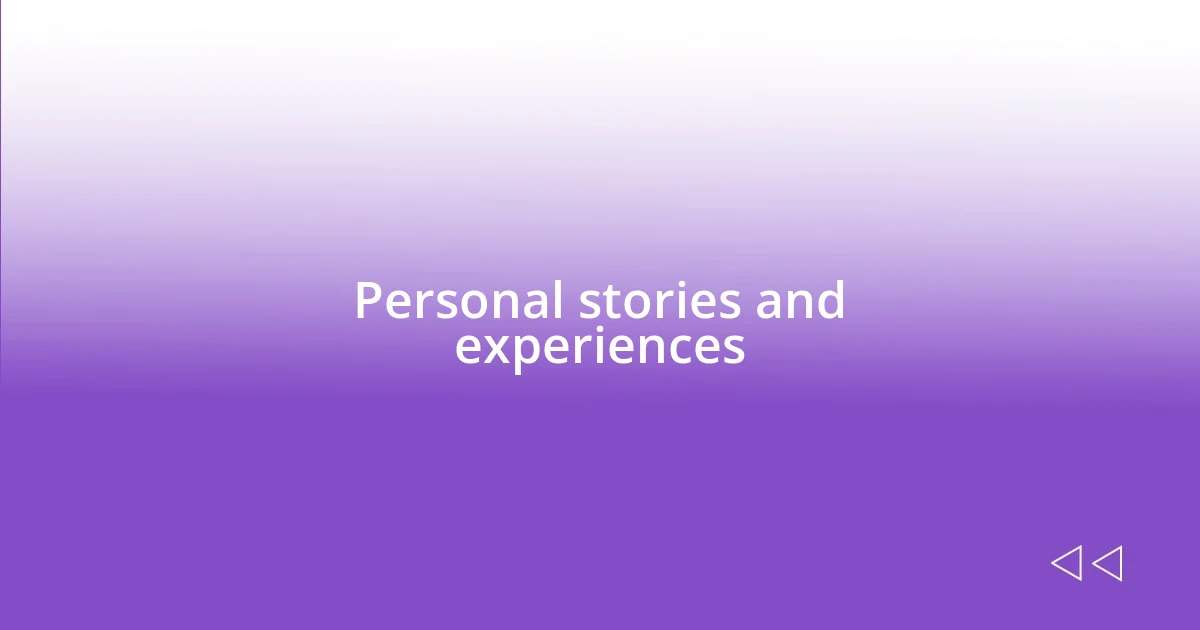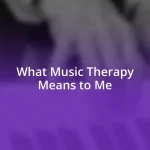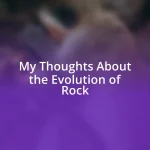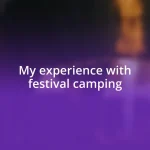Key takeaways:
- Advocating for festival accessibility is essential for creating inclusive experiences, with community engagement highlighting common barriers faced by attendees.
- Key accessibility features like designated pathways, well-trained staff, and clear signage significantly enhance the festival experience for individuals with mobility challenges.
- Effective communication with organizers and utilizing resources like social media can improve awareness and access to essential information about festival amenities.

My journey to festival accessibility
Attending festivals has always been a passion of mine, but navigating the accessibility options can feel overwhelming. I remember my first experience at a festival, where I found myself lost among the crowds, struggling to locate accessible entrances and restrooms. Have you ever felt that way? It’s such a disheartening feeling.
As I continued to explore various festivals, I began to notice a stark difference in how accessibility was prioritized. At one particularly memorable event, the staff were genuinely helpful, guiding me to accessible viewing areas with enthusiasm. It made me wonder—how would my experience change if this level of care was standard across all festivals?
Over time, I realized that advocating for accessible festivals isn’t just about making logistics easier; it’s about fostering an inclusive community. When I shared my struggles with friends, many of them had similar stories. This collective experience sparked conversations on how festivals can become more welcoming, and it became clear to me that our voices matter. What does it mean to us as festival-goers when those barriers are lifted?

Understanding festival accessibility barriers
Understanding festival accessibility barriers can sometimes feel like peeling back layers of a complex onion. One major barrier I’ve encountered is the physical layout of festival grounds. I remember attending an event that was set up on a hillside, which made it incredibly difficult for me and others with mobility challenges to navigate. The absence of ramps and accessible pathways made me acutely aware of how many potential attendees may have felt discouraged from attending altogether.
In another instance, I experienced firsthand the frustration of inadequate signage. At one festival, I was searching for accessible facilities and found the clues leading to them scattered and unclear. After finally locating a restroom, I couldn’t help but think about how confusing it could be for someone less familiar with the layout. It’s in these moments that I truly appreciated the importance of not just having accessible options but ensuring they are clearly marked and easy to find.
Additionally, the lack of trained staff members is another accessibility barrier that I’ve often faced. While some festivals have incredible volunteers who are eager to assist, others seemed unprepared or unaware of how to help. I vividly remember a time when I approached a staff member for directions, only to be met with uncertainty. It left me feeling more isolated just when I needed support. This inconsistency in service can drastically impact the experience, highlighting the need for better training and awareness across the board.
| Barrier Type | Impact on Experience |
|---|---|
| Physical Layout | Difficulty navigating on hills or uneven surfaces, discouraging attendees. |
| Inadequate Signage | Created confusion and frustration in locating accessible facilities. |
| Lack of Trained Staff | Resulted in feelings of isolation and unhelpfulness when assistance was needed. |

Essential accessibility features at festivals
Accessibility features at festivals can make a world of difference for attendees like me. I still recall an event where the presence of dedicated accessible routes transformed my experience. Instead of maneuvering through thick crowds, I found myself gliding along smooth paths specifically designed for easy access. The feeling of liberation was palpable, and I couldn’t help but smile as I navigated effortlessly from stage to stage.
Here are some essential accessibility features that enhance the festival experience:
– Accessible Transportation: Shuttles or public transport options that accommodate mobility aids.
– Wide Paths: Sufficiently spaced walkways that allow easy movement for those using wheelchairs or scooters.
– Accessible Viewing Areas: Designated spots at stages where everyone can enjoy the performance without obstruction.
– Clearly Marked Facilities: Signage indicating the location of accessible restrooms, parking, and services.
– Well-Trained Staff: Festival personnel who are knowledgeable about accessibility options and responsive to the needs of attendees.
I can’t stress enough how important it is for festivals to feature sensory-friendly zones. At one particularly loud event, I found myself overwhelmed by the noise and crowds. Thankfully, I discovered a quiet area that allowed me to recharge without the sensory overload. This brief respite made the festival so much more enjoyable, letting me enjoy the moments that truly mattered without feeling mentally drained.
Additionally, the inclusion of assistive technology, like hearing loops or captioning for performances, is a game changer. I remember attending a show where I could access real-time captions, allowing me to fully engage with the artist’s words and emotions without straining to hear over the crowd. Such features create a space where everyone feels valued and included, which is truly the essence of a festival experience.

Navigating transportation and parking
When navigating transportation and parking at festivals, I often find it to be a mixed bag. I once attended a large music festival where accessible parking was a considerable distance from the entrance. Despite having a designated area, the long trek made it exhausting for those with mobility issues, myself included. It raised the question: why isn’t the accessible parking closer to the main entrance? After all, accessibility shouldn’t end at the parking lot.
Public transport options play a significant role too. I’ve had experiences where shuttle services were advertised as accessible, but when I arrived, the reality didn’t match up. The vehicles were either cramped or lacked proper accessibility features like lifts. This disconnect made me realize how crucial it is for organizers to provide accurate information about transportation options. If we’re promised convenient access, it should genuinely be delivered to make our experience as enjoyable as it should be.
On another note, I once had a friend drop me off right at the entrance of a festival, and the relief I felt was immense. Having drop-off zones specifically designed for those needing assistance would have been fantastic, don’t you think? It’s all about those small details that can drastically change our experience. Accessible transportation and parking should not just be afterthoughts; they should be essential components of thoughtful festival planning.

Tips for festival accessibility preparation
While planning for festival accessibility, I’ve learned that communication is key. Before attending any event, I always reach out to organizers to ask specific questions about their accessibility features. For instance, I once contacted a festival a week prior and found they had added additional accessible seating areas based on feedback from previous years. This proactive approach not only provided me with peace of mind but also gave me a sense of being heard as an attendee.
Another tip is to do a bit of reconnaissance ahead of time. If the festival has a website or a social media presence, I often look for maps that detail accessible routes and facilities. I remember attending one festival where the layout was quite confusing, but having a visual ahead of time allowed me to mentally map out my path. It’s like setting a game plan—knowing where I could find accessible restrooms or quiet zones made my experience much smoother.
Lastly, consider the essentials you’ll need for the day. I always pack a small bag with items like snacks, water, and maybe a portable charger for my devices. There was an instance when I underestimated the heat and ended up needing sunscreen, which I hadn’t brought. It’s the little things that can shift your experience from stressful to enjoyable, and being prepared truly empowers you to focus on fun rather than logistics.

Personal stories and experiences
I remember the first time I arrived at a festival and saw the accessible seating area. It felt like a breath of fresh air. I was initially hesitant to occupy a space that seemed so conspicuous, but when I settled in, I realized this was my chance to enjoy the performance without straining myself. Have you ever been in a situation where you hesitated to claim your space, only to find it was exactly where you needed to be? That experience taught me the importance of creating inclusive environments where everyone feels they belong.
At another festival, I was caught off guard by the lack of accessible pathways. As I navigated through crowds, I was struck by the frustration of not being able to find a clear route to the stage. I adapted by creating my own detours, weaving between people and tents. In those moments, I felt a mix of determination and exasperation. Why is it that something as fundamental as clear pathways seems to be an afterthought? It’s disheartening when the focus on accessibility doesn’t match the excitement of festival culture.
I also recall a moment that warmed my heart. I was at a festival when a stranger noticed my struggles with a crowded area. Without hesitation, they offered their arm for support, guiding me through the throngs of people. That small act of kindness made all the difference, reminding me that while some details can be overlooked, human compassion is a powerful force. Have you ever experienced a simple gesture that lifted your spirits in challenging times? It’s those unexpected connections that can transform our experiences, even amidst the chaos of a bustling festival.

Resources for accessible festival information
When searching for accessible festival information, I often turn to dedicated resources that consolidate helpful data. Websites like Accessible Festivals offer invaluable insights about various events, including details on amenities, accessibility features, and even reviews from attendees with disabilities. There’s something comforting about knowing you’re not alone in navigating these spaces—doesn’t it feel encouraging when others share tips from their own experiences?
Social media can also be a treasure trove of accessible insights. I’ve found that following relevant hashtags or festival pages can reveal firsthand accounts and updates that you might not find on official websites. For instance, one year I saw a post where someone shared photos of ramps and accessible entrances at the festival, which helped me feel more prepared. So, when was the last time you tapped into the collective knowledge of a community?
Don’t overlook the importance of direct communication with festival organizers. I have had instances where simply sending an email or a message on social media resulted in a quick response with details I hadn’t considered. For example, when I inquired about the availability of sensory-friendly spaces, they not only provided a map but also explained how they were adapting to meet diverse needs this year. It’s these proactive conversations that transform an ordinary festival visit into an empowering experience, wouldn’t you agree?














